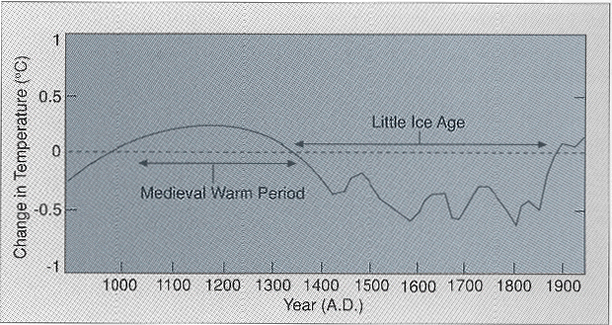See other Science/Tech Articles
Title: Tree Rings Show Earth May Have Global Cycles of Warming, Cooling
Source:
The Arizona Republic Saturday, March 23, 2002
URL Source: [None]
Published: Dec 22, 2007
Author: AP
Post Date: 2007-12-23 00:13:35 by richard9151
Ping List: *Agriculture-Environment* Subscribe to *Agriculture-Environment*
Keywords: None
Views: 118
Comments: 3
WASHINGTON -- An unusually warm period a millennium ago may have been part of a natural planetary cycle, researchers say in a study of tree rings that scrutinizes the link between human activity and climate change. The study, appearing Friday in the journal Science, analyzed ancient tree rings from 14 sites on three continents in the Northern Hemisphere and concluded that temperatures in an era known as the Medieval Warm Period about 800 to 1,000 years afo closely matched the warming trend of the 20th century. In recent years, many climate scientists have said an unprecedented warming spell that began last century and continus is caused by the greenhouse effect. The greenhouse effect is blamed on an increase in the atmosphere of gases, principally carbin dioxide, from the burning of fossil fuels, which trap heat just lile glass panes in a greenhouse. The tree-ring study gives another perspective on Earth's natural cycles, said Edward Cook of the Lamont-Doherty Earth Observatory in Palisades, N.Y. Cook is co-author of the study with Jan Esper and Fritz Schweingruber of the Swiss Federal Research Institute. Cook said the study shows the Earth to be "capable of rapid changes and long periods of above average warmth on its own without greenhouse warming." Cook said, "It shows that there are processes within the Earth's natural climate system that produce large changes that might be viewed as comparable to what we have seen in the 20th century. "Greenhouse gases were not a factor back in the Medieval Warm Period," Cook said. The Intergovernmental Panel on Climate Change, an international group, has predicted that the current warming trend will continue deep into the 21st century, with average temperatures rising 2.5 to 10 degrees. Based on this prediction, there have been international proposals for systematic reductions in the burning of fossil fuels. The propsoal has been tesisted by the united States, particularly the Bush administration. Cook said data used in the climate change panel's calculations is based on a model that compared the Preiondustral Age climate with the climate of the 20th century. The model did not include a Medieval Warm Period. Including data from that era could change the calculations, Cook said. "The Medievel Warm Period is in some sense comparavle up to 1990 in the 20th century," Cook said. "
Post Comment Private Reply Ignore Thread
Top • Page Up • Full Thread • Page Down • Bottom/Latest
#1. To: richard9151 (#0)
"The Medievel Warm Period is in some sense comparable up to 1990 in the 20th century," Cook said. "But that does not say that the 20th century hasn't been perturbed by greenhouse gases. The real challenge is to factor out the natural variability from (man-made) causes of global warming."
When a man who is honestly mistaken hears the truth, he will either quit being mistaken or cease to be honest.
At only one part in 3,000 there is far too little CO2 in the atmosphere to have any effect on global temperture. Futhermore, man has almost nothing to do with the level of CO2. During the Medieval Warm Period the CO2 level was higher and it was lower during the Little Ice Age. However, CO2 levels are not the reason any more than the leaves tuning brown and falling off the trees causes snow. CO2 levels are lagging indicators. During warm periods the ocean heats up and releases CO2. During cool periods the ocean cools and absorbs CO2. Waper vapor and not CO2 is earth's greenhouse gas.

My spelling is Wobbly. It's good spelling but it Wobbles, and the letters get in the wrong places. -- Winnie the Pooh
#2. To: All (#0)
Sorry -- my puter froze and I could not finish, nor proof read.
#3. To: richard9151 (#0)
Top • Page Up • Full Thread • Page Down • Bottom/Latest